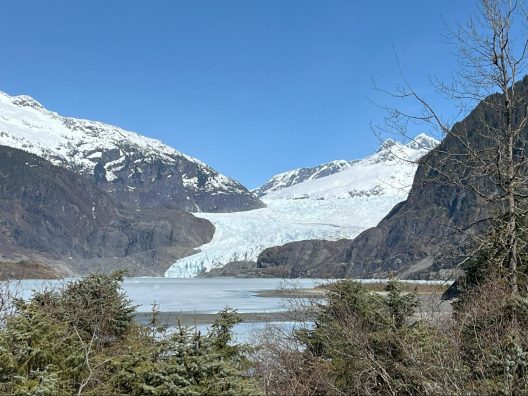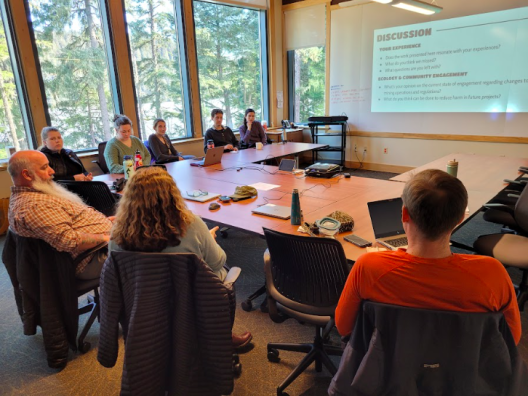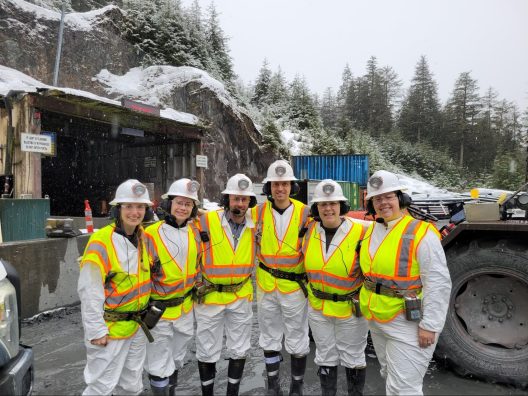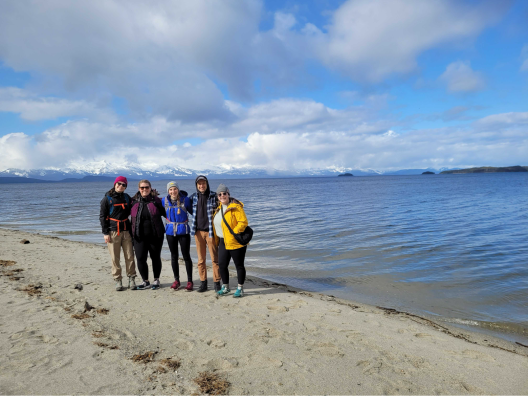Digging Deep into Alaska Hardrock Mines
The door slowly slid open as all five of us climbed out of the three-row van—affectionately named the “sassy Sienna”—emerging onto a dark, wet, nearly empty marina. The rain softly fell onto the hoods of our jackets as we surveyed the scene, no one quite awake, looking for our next mode of transportation. It was 4:30 AM, and we were scheduled to board a ferry with a shift of mine workers sailing towards Admiralty Island National Monument and our much-anticipated tour of Greens Creek mine.
Joined by one of our fearless leaders and capstone client, Chris Sergeant, we checked in with security, boarded the diesel-smelling vessel one by one, and found an open row to catch a few extra minutes of shut-eye. A short 45-minute boat ride later, we emerged onto the rain-slicked metal grating of the Greens Creek dock as the mine shift changed. It felt more like a changing of the guard as the two single-file lines passed one another: one boarding the boat back to town for some much-needed rest, the other about to start their next shift deep underground within Greens Creek mine. Each new arrival—mostly camo-clad men in knee-high XTRATUFs—slowly trudged up the grated ramp, occasionally nodding to one another in silence. We then integrated ourselves into the line of mine workers heading towards the waiting school bus that would transport us to the mine’s main hub and our day-long tour of Greens Creek.
Before we share what life 1400 feet below sea level was like, let’s set the scene. Just two days prior, our capstone team had arrived in Juneau, Alaska, to present our research on the regulatory processes governing the expansion of Alaska’s five major hardrock mines: Red Dog, Greens Creek, Kensington, Fort Knox, and Pogo. We came to Juneau to discuss our work with four relevant groups involved in the social and ecological complexities surrounding mine impacts, take part in a once-in-a-lifetime tour of an underground silver mine, and explore the region’s natural spaces to better understand the context for embarking on this research.

You may be wondering why five graduate students from the School of Marine and Environmental Affairs (SMEA) were studying hardrock mines in Alaska in the first place. We’re not geologists, nor are we motivated to grab a pickaxe and start breaking rocks (although it might be fun). The interest in this capstone project stemmed from something bigger: a drive to understand both the processes that make extraction of natural resources possible and the roles that people play in those processes. Our modern society has drastically expanded the scale and impacts of extractive industries like mining. For us, studying the expansion of hardrock mines in Alaska was an avenue to learn more about an industry far removed from our daily lives yet central to our modern existence.
“The interest in this capstone project stemmed from something bigger: a drive to understand both the processes that make extraction of natural resources possible and the roles that people play in those processes.”
Many of us are preoccupied with questions about how we should interact with the natural world. Is extraction necessary to sustain our modern amenities? Where do we draw the line with the exploitation of ecological systems? As the climate crisis makes these dilemmas more salient, the potential benefits of resource extraction must be weighed against any negative trade-offs. Mining is often touted as a crucial industry in securing a clean energy future. This is true; minerals like lithium, cobalt, and copper are essential for electric vehicles and renewable energy. Mining, however, can also be incredibly harmful to both environmental and human health when conducted without thorough consideration and investigation of potential impacts. These impacts often disproportionately fall on certain communities; a majority of critical minerals like copper, nickel, and lithium are found on or near Indigenous lands. How can the global benefits of mitigating climate change be achieved while minimizing the impacts that mines can have on ecosystems and communities?
If we view the mining industry as essential, we should ensure that its impacts are known and regulated. But let’s be real: not all mining is essential. Most of the mines studied in our capstone research targeted gold, a non-critical mineral. Nearly 50% of global gold demand is for jewelry, with only a small, single-digit percentage going to technological uses. Whether or not we can continue to justify such an industry for the production of luxury goods is a question with which society will need to grapple.
We thought a lot about these dilemmas as we conducted our research and shared our results in Juneau. On our first day there, we took a hike to see the famed Mendenhall Glacier. While magnificent and stunning, the receding ice was a stark reminder of the reason we are doing this work in the first place. Many natural places are threatened with erasure because of climate change, and we are all determined to contribute what we can to stop that from happening. Hours spent poring through regulatory documents and public comment records during our research might not feel like climate action, but if it means one more drop of water stays frozen in that glacier, then it’s worth it. Ultimately, this time spent researching would be less impactful without the opportunity to have conversations with people directly impacted by and managing these issues.
“Hours spent poring through regulatory documents and public comment records during our research might not feel like climate action, but if it means one more drop of water stays frozen in that glacier, then it’s worth it.”
The excitement of arriving in Alaska was still fresh as we arrived at the U.S. Forest Service office, the first of four in-person presentations we would give. On our second day of presentations, we kicked our day off with SalmonState, an Alaska-led initiative that advocates for salmon recovery and restoration of wild Alaskan salmon. Next, we shared our presentation with representatives from the Central Council of Tlingit and Haida Tribes. We finished the second day with a final conversation with University of Alaska Southeast undergraduates enrolled in a mining and minerals-focused course.

Each presentation ended with rich discussions about the nuances of the National Environmental Policy Act (NEPA) process, environmental impacts, and the economic benefits of mining. While we heard a wide range of opinions, a handful of constants emerged, encouraging us to reflect deeply on our work. We empathized with the Herculean effort it takes to create and review an environmental impact statement within the NEPA process. We know it’s difficult to read such long and jargon-heavy documents, let alone create one from scratch; after all, in-depth review of these robust environmental analyses formed the basis of our capstone research. We also understood the public sentiment of feeling in the dark about how these decisions are made. These same lengthy documents are arduous to consume and understand, and how a decision is made is not always obvious after reading them.
After our whirlwind of meetings, we all felt so appreciative of the opportunity to visit different groups face-to-face on their home turf rather than remotely. We had been concerned about how local Alaskans might perceive us, considering we were out-of-state students drawing conclusions about the role and impacts of mineral resource extraction in the home of people who live with the daily realities of mining. These fears were eased by the thoughtful discussions we had with our gracious Alaska hosts.
Our time in Juneau brought into focus what, in many ways, was at the core of our work: human connectivity. We were heartbroken to see the drill removing cores of the earth during the mine tour, but we were also concerned for the physical and mental well-being of mine workers. While dark gray skies are often the norm in Seattle, we had to adjust to headlamps and tractor headlights as our only sources of light in the underground tunnels. We’re also not strangers to running across campus between meetings, but we do not normally have to wash caked-on layers of dirt off our faces as we did that day. It was a relief when the soot washed down the drain, but we tried not to think too hard about what remained in our lungs after just a few hours in the tunnel.
“We also have to remember our own connection to the environment—we are not separable.”
In a broader context, it can be easy to forget the real people involved in environmental and resource extraction work by burying it under agency and corporation names and spending time in the weeds of policies and regulations. We may have been guilty of this earlier in our research process, but through our tour and conversations, we were reminded that these organizations are made up of people incredibly passionate about their work. Sometimes passion can keep us in communities of like-minded people. While this can be comfortable, environmental work is rarely one-sided and without trade-offs. To make progress on environmental issues, we have to be able to see multiple angles of a problem and remember the people behind the other side. We also have to remember our own connection to the environment—we are not separable.

It feels like just yesterday we emerged from that mine tunnel, the cold air blasting our soot-stained faces, eyes squinting in the daylight. In some ways, that’s how it felt to come out on the other side of this capstone project. We spent nearly a year in the tunnels of government documents, turning corner after corner to find valuable nuggets at times and bare rock at others. There is something to be said about getting in the weeds. Extensively exploring the products of a highly criticized, government-mandated process was eye-opening for us as students of environmental policy, educating us in a way that no class ever could. There is also something to be said about stepping back and seeing the big picture, a cherished skill we’ve cultivated throughout our time here at SMEA. They are, in fact, two sides of the same coin—both play their role in instigating the change that we want to see.

Numerous questions are left on our minds as we near the end of our master’s program, but none bigger than “what’s next?” In terms of our research, we hope that this kind of work continues. Delving into interviews with community members, agency officials, and beyond could substantially deepen the investigation into the social and ecological impacts of mining projects and their expansions. Breaking down communication barriers by providing plain language summaries and translating agency jargon could help to bridge those community knowledge gaps about how their surrounding landscape will change in these scenarios.
We’ve also been considering what’s next for us as individuals as we head off into our own careers. We all hope to stay in Washington and enter the workforce to tackle policy issues, promote community education and engagement, and foster environmental resilience against climate change. It will certainly be a challenge to leave the wonderful community that we’ve formed here at SMEA, but we know that (pardon the mining metaphor) those veins run deep, and it’s never really goodbye.
We could not have completed this capstone project without the invaluable help of so many. We are incredibly grateful to those who provided context and guided our thinking early on in the process, as well as those who listened to our work and provided feedback toward the end. We’re also grateful for the generous support of donors who made this enriching experience possible, including the SMEA Fellowship Fund, Ed Miles Memorial Student Support Fund, the Dayton “Lee” Alverson Fellowship, and the Usha and S. Rao Varanasi Endowed Fellowship in Environmental and Marine Stewardship.
Last but most certainly not least, we extend our sincerest gratitude to our advisors, Anne Beaudreau and Chris Sergeant. Your unparalleled guidance and patience were the driving force behind this capstone; without it, we would not have developed into the lifelong students and professionals that we are today. (We also probably wouldn’t be dreaming of environmental impact statements, and you better believe we’re holding you accountable for that.) “Thank you” doesn’t quite seem to begin to cover it.